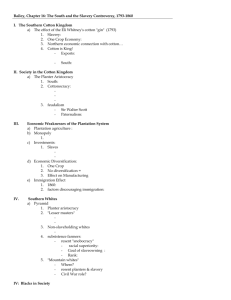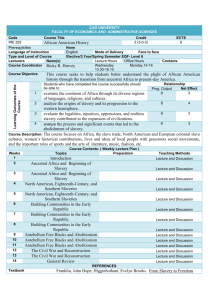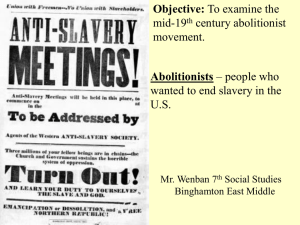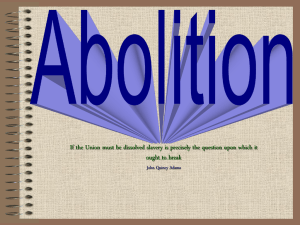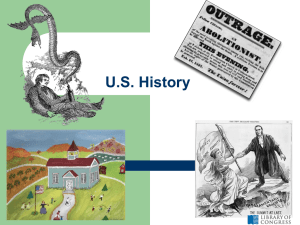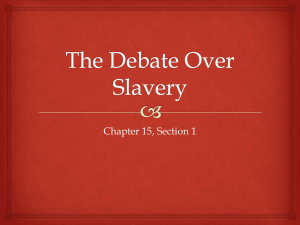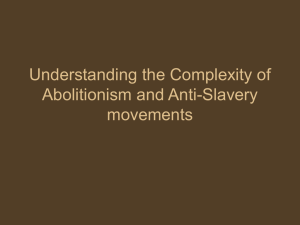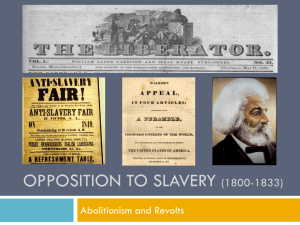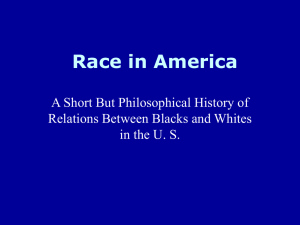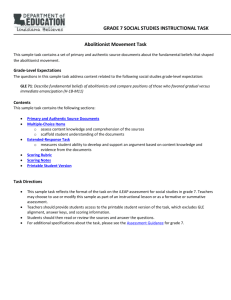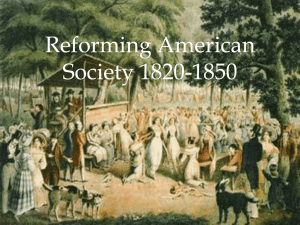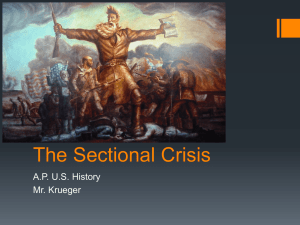Abolition
advertisement
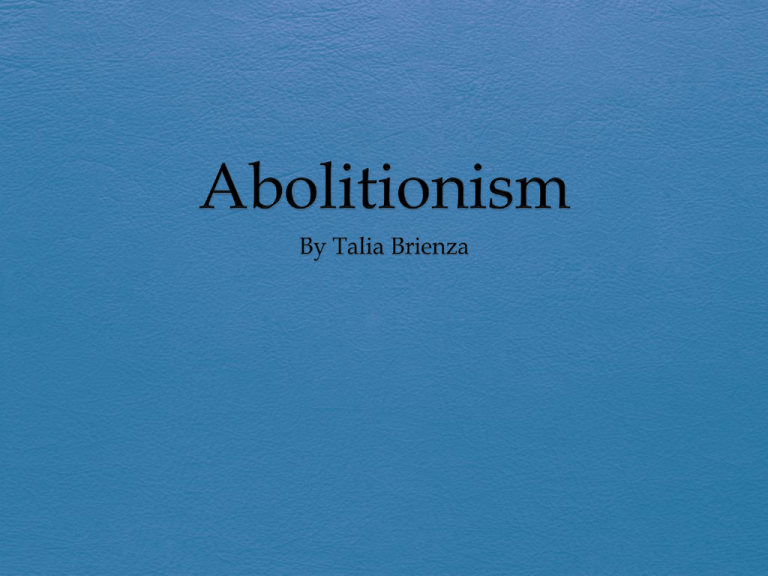
The Second Great Awakening During the 1820’s and 1830’s there were many social movements working to reform American society, with inspiration coming from the Second Great Awakening. Slavery was no regarded as “…an unparalleled sin…”( the religious conviction) and that “…it contradicted the values enshrined in the Declaration of Independence (secular conviction). It added a religious underpinning to the celebration of personal selfimprovement , self-reliance, and self-determination, originally organized by established religious leaders, but quickly expanded beyond churches It is characterized from the religious revivals that pervaded the North and South, offering salvation to sinners and improvement throughout society Despite national recognition for some reform movements, some only existed in the North, the most notable being the militant movement “…demanding the immediate abolition of slavery and the incorporation of blacks as equal citizens of the republic”. How Abolitionists Spread Their Message During this time, abolitionists focused their discussions on freedom based on the “…sharp contradiction between liberty and slavery” (382) -”They promoted an understanding of freedom as control over one’s self and participation as an equal member in social and political life”. They printed newspapers, pamphlets and books Their own protests not only placed the issue of slavery on the national agenda but also inspired others, including women. As they worked in the antislavery movement, they became aware of their own lack of rights and opportunities Abolitionists argued that slavery was so deeply embedded in American society that in order to change it, there would have to be fundamental changes in the North AND South “They worked to attack the intellectual foundation of racism, seeking to disprove pseudoscientific arguments for black inferiority” They called on free blacks to seek “…skilled and dignified employment, to demonstrate the race’s capacity for advancement” Gradualists VS Immediatists Immediatists- radical approach to abolitionism William Lloyd Garrison (1805-1879) Raised solely by his mother, who also got him his first apprenticeship with a newspaper publisher After his apprenticeship, his writings were often attacks on politics and politicians- an editorial referring to a slave holder as a “murderer” caused him to be sued for libel. He was convicted and went to jail, which proved to be a lifechanging experience In jail, he listened to the stories of blacks, completely changing his views and for forty-nine days he wrote editorials “…demanding ‘immediate emancipation’ of all slaves” On January 1, 1831, Garrison began publishing The Liberator, which would eventually become the leading abolitionist newspaper He helped found the New England Anti-Slavery Society- he demanded complete equality for EVERYONE He was the most notable propagandist “I am aware that many object to the severity of my language, but is there not cause for severity? I will be as harsh as truth, and as uncompromising as justice. On this subject, I do not wish to think, or to speak, or write, with moderation. No! no! Tell a man whose house is on fire to give a moderate alarm; tell him to moderately rescue his wife from the hands of the ravisher; tell the mother to gradually extricate her babe from the fire into which it has fallen; -but urge me not to use moderation in a cause like the present. I am in earnest- I will not equivocate-I will not excuse- I will not retreat a single inch- AND I WILL BE HEARD”. Frederick Douglas (1818-1895) Was the son of a slave mother and an unidentified white male From an early age he desired freedom. He secretly taught himself to read and write. Later he stated that “From that moment I understood that knowledge was the pathway from slavery to freedom” He experienced slavery in every way. At age 15, his owner sent him to a “slave breaker” and after numerous whippings , he refused to allow himself to be disciplined again. He refers to this confrontation as the “… turning point on my career as a slave” He escaped to the North in 1838 He became the most influential African American advocate – he lectured against slavery throughout the North and British Isles , edited anti-slavery publications, published an autobiography, and was active in other movements, including the campaign for women’s rights. During the Civil War, he advised Abraham Lincoln on employing blacks as well as giving them the right to vote Overall, he believed that slavery would only be overthrown by continuous resistance- of which he demonstrated throughout his life The Tappan Brothers Arthur and Lewis Tappan were both prominent businessmen They joined local groups dedicated to abolition They demanded “universal liberty.” Working with African Americans such as Frederick Douglass, Samuel Cornish, and Henry Highland Garnet, the brothers accomplished many things. They helped found the New York Anti-Slavery Society and were actively part of the Underground Railroad. Lewis organized the defense for the Africans of the slave ship Amistad. The brothers also gave money to integrated colleges, abolitionist newspapers, and many other anti-slavery organizations. The Grimké Sisters Daughters of a prominent North Carolina slave-holder (Angelina and Sarah) First converted to Quakerism and then abolitionism when visiting Philadelphia During the 1830’s they began delivering lectures that offered condemnation of slavery after witnessing it firsthand and were denounced by some due to their sacrifice of all “modesty and delicacy” They retaliated with the fact that women should be able to take part in political debates, and have equal social and educational opportunities given to men Sarah published a book, Letters on the Equality of the Sexes (1838), a call for equal rights, and would raise issues applicable even to today’s society (equal pay for equal work) “They were the first to apply the abolitionist doctrine of universal freedom and equality to the status of women” Their writings helped spark the movement for women’s rights (even after they retired), which came about in the 1840’s What Encouraged the Growth of Abolitionism -”Wage slavery”, popularized by the era’s labor movement, abolitionists argued that in comparison to a slave, “…the person working for wages was an embodiment of freedom…” -The growing participation of women in the anti-slavery movements ( Some believed that there was a defined role for women in regards to political movements, causing a schism in abolitionism). This ultimately caused over 1,000 antislavery societies to be scattered throughout the North Technological advancements- The use of pamphlets, writings, etc Successful? Abolitionism now became an important reform movement within American society due to awareness “ The abolitionists’ greatest achievement lay in shattering the conspiracy of silence that had sought to preserve national unity by suppressing public debate over slavery” References America, Empire of Liberty. A New History of the United States. David Reynolds. Copyright 2009 Freedom- A History of US. Joy Hakim. Copyright 2003 Give Me Liberty! An American History. Eric Foner. Copyright 2005 http://maap.columbia.edu/place/5.html http://www.powayusd.com/teachers/clewis/abolitionism_in_the_u nited_state.htm



